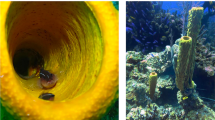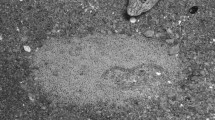Abstract
Ecological context generates interspecific variation in mating behavior by imposing differential constraints on the action of sexual selection, but operation of these constraints in nature is not well understood. We used field and laboratory studies to examine the importance of body size and size of sexually dimorphic appendages, the gnathopods, for pairing success in two freshwater amphipod species within the Hyalella azteca species complex. We focused on a large-bodied species found in habitats where ecological factors tend to favor large body size, and a small-bodied species in habitats where small body size is favored by size-selective predation. A field study indicated that although male pairing success was greater for larger males in both species, pairing success increased throughout the range of variation in male size in the large species, whereas, in the small species, pairing success was low for smaller individuals, but roughly constant across intermediate to larger sizes. A laboratory mate choice experiment was consistent with the field study, finding that females of the large species exhibited a preference for larger males that was independent of absolute male size, but females of the small species were indifferent when choosing between males of intermediate to larger size. Species also differed in the direction of sexual size dimorphism in the field, with males being the larger sex in the large species but the smaller sex in the small species, a pattern consistent with the species differences in mate preference. Large gnathopod size relative to body size was associated with enhanced pairing success across all body sizes for the large species, but, in the small species, large gnathopod size enhanced pairing success only in smaller males. Species differences in mating behavior appear consistent with change driven by differing forms of the interaction between sexual and natural selection.





Similar content being viewed by others
References
Andersson M (1994) Sexual selection. Princeton University Press, Princeton
Arnold SJ, Wade MJ (1984) On the measurement of natural and sexual selection: applications. Evolution 38:720–734
Borowsky B (1984) The use of males’ gnathopods during precopulation in some gammaridean amphipods. Crustaceana 47:245–250
Bousfield EL (1973) Shallow-water gammaridean Amphipoda of New England. Cornell University Press, Ithaca
Burk T (1982) Evolutionary significance of predation on sexually signaling males. Fl Entomol 65:90–104
Cooper WE (1965) Dynamics and production of a natural population of a fresh-water amphipod, Hyalella azteca. Ecol Monogr 35:377–394
Cothran R (2004) Precopulatory mate guarding affects predation risk in two freshwater amphipod species. Anim Behav (in press)
Edley MT, Law R (1988) Evolution of life histories and yields in experimental populations of Daphnia magna. Biol J Linn Soc 34:309–326
Edwards TD, Cowell BC (1992) Population dynamics and secondary production of Hyalella azteca (Amphipoda) in Typha stands of a subtropical Florida lake. J North Am Benthol Soc 11:69–79
Emlen ST, Oring LW (1977) Ecology, sexual selection, and the evolution of mating systems. Science 197:215–223
Endler JA (1983) Natural and sexual selection on color patterns in poeciliid fishes. Environ Biol Fishes 9:173–190
Endler JA, Houde AE (1995) Geographic variation in female preferences for male traits in Poecilia reticulata. Evolution 49:456–468
Hartnoll RG, Smith SM (1978) Pair formation and the reproductive cycle in Gammarus duebeni. J Nat Hist 12:501–511
Harvey AW (1990) Sexual differences in contemporary selection acting on size in the hermit crab Clibanarius digueti. Am Nat 136:292–304
Houde AE (1997) Sex, color, and mate choice in guppies. Princeton University Press, Princeton
Houde AE, Endler JA (1990) Correlated evolution of female mating preferences and male color patterns in the guppy Poecilia reticulata. Science 248:1405–1408
Johnson JB, Basolo AL (2003) Predator exposure alters female mate choice in the green swordtail. Behav Ecol 14:619–625
Jormalainen V (1998) Precopulatory mate guarding in crustaceans: male competitive strategy and intersexual conflict. Q Rev Biol 73:275–304
Jormalainen V, Merilaita S (1995) Differential predation on sexes affects colour polymorphism of the isopod Idotea baltica (Pallas). Biol J Linn Soc 55:45–68
Kokko H, Brooks R, McNamara JM, Houston AI (2002) The sexual selection continuum. Proc R Soc London B 269:1331–1340
Kokkotis AT, McLaughlin JD (2002) Inter-specific head and body lengths of Hyalella (Amphipoda): criteria for starting and endpoints in experimental studies. Hydrobiologia 474:223–227
Lande R (1981) Models of speciation by sexual selection on polygenic traits. Proc Natl Acad Sci USA 78:3721–3725
Law R (1979) Optimal life histories under age-specific predation. Am Nat 114:399–417
Partridge L, Endler JA (1987) Life history constraints on sexual selection. In: Bradbury JW, Andersson MB (eds) Sexual selection: testing the alternatives. Wiley, New York, pp 265–277
Pickard DP, Benke AC (1996) Production dynamics of Hyalella azteca (Amphipoda) among different habitats in a small wetland in the southeastern USA. J North Am Benthol Soc 15:537–550
Promislow DEL, Montgomerie R, Martin TE (1992) Mortality costs of sexual dimorphism in birds. Proc R Soc London B 247:203–210
Real LA (1990) Search theory and mate choice. I. Models of single sex discrimination. Am Nat 136:376–405
Robinson BW, RW Doyle (1985) Trade-off between male reproduction (amplexus) and growth in the amphipod Gammarus lawrencianus. Biol Bull 168:482–488
Schluter D (1988) Estimating the form of natural selection on a quantitative trait. Evolution 42:849–861
Shuster SM, Wade MJ (2003) Mating systems and strategies. Princeton University Press, Princeton
Sokal RR, Rohlf FJ (1995) Biometry, 3rd edn. Freeman, New York
Sparkes TC, Keogh DP, Haskins KE (2000) Female resistance and male preference in a stream-dwelling isopod: effects of female molt characteristics. Behav Ecol Sociobiol 47:145–155
Strong DR Jr (1972) Life history variation among populations of an amphipod (Hyalella azteca). Ecology 53:1103–1111
Strong DR Jr (1973) Amphipod amplexus, the significance of ecotypic variation. Ecology 54:1383–1388
Taylor BE, Gabriel W (1992) To grow or not to grow: optimal resource allocation for Daphnia. Am Nat 139:248–266
Trail PW, Adams E (1989) Active mate choice at cock-of-the-rock leks: tactics of sampling and comparison. Behav Ecol Sociobiol 25:283–292
Underwood AJ (1997) Experiments in ecology. Cambridge University Press, Cambridge
Ward PI (1988) Sexual selection, natural selection, and body size in Gammarus pulex (Amphipoda). Am Nat 131:348–359
Wellborn GA (1994a) Size-biased predation and the evolution of prey life histories: a comparative study of freshwater amphipod populations. Ecology 75:2104–2117
Wellborn GA (1994b) The functional basis of body size differences between Hyalella (Amphipoda) species. J Freshwater Ecol 9:159–168
Wellborn GA (1995a) Determinants of reproductive success in freshwater amphipod species differing in body size and life history. Anim Behav 50:353–363
Wellborn GA (1995b) Predator community composition and patterns of variation in life history and morphology among Hyalella (Amphipoda) populations in southeast Michigan. Am Midl Nat 133:322–332
Wellborn GA (2000) Selection on a sexually dimorphic trait in two ecotypes of Hyalella amphipods (Amphipoda: Hyalellidae). Am Midl Nat 143:212–225
Wellborn GA (2002) Tradeoff between competitive ability and antipredator adaptation in a freshwater amphipod species complex. Ecology 83:129–136
Wellborn GA, Cothran RD (2004) Similarity and differentiation in life history and morphology among sympatric cryptic species in an amphipod species complex. Freshwater Biol 49:1–13
Wellborn GA, Skelly DK, and Werner EE (1996) Mechanisms creating community structure across a freshwater habitat gradient. Annu Rev Ecol Syst 27:337–363
Wellborn GA, Cothran R, Bartholf S (2005) Life history and allozyme diversification in regional ecomorphs of the Hyalella azteca (Crustacea: Amphipoda) species complex. Biol J Linn Soc (in press)
Wen YH (1993) Sexual dimorphism and mate choice in Hyalella azteca (Amphipoda). Am Midl Nat 129:153–160
Wilkinson L (2002) SYSYAT 10.2. SYSYAT, Chicago, Ill.
Witt JDS, Hebert PDN (2000) Cryptic species diversity and evolution in the amphipod genus Hyalella within central glaciated North America: a molecular phylogenetic approach. Can J Fish Aquat Sci 54:687–698
Zuk M, Kolluru GR (1998) Exploitation of sexual signals by predators and parasitoids. Q Rev Biol 73:415–438
Acknowledgements
We thank Rickey Cothran, Trish Schwagmeyer, and anonymous reviewers for insightful comments that improved the manuscript. Research was supported by the National Science Foundation (DEB 98–15059).
Author information
Authors and Affiliations
Corresponding author
Rights and permissions
About this article
Cite this article
Wellborn, G.A., Bartholf, S.E. Ecological context and the importance of body and gnathopod size for pairing success in two amphipod ecomorphs. Oecologia 143, 308–316 (2005). https://doi.org/10.1007/s00442-004-1786-x
Received:
Accepted:
Published:
Issue Date:
DOI: https://doi.org/10.1007/s00442-004-1786-x




